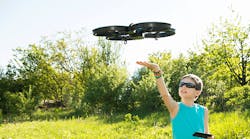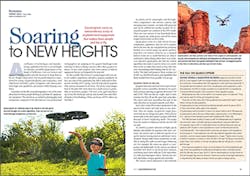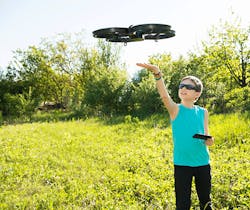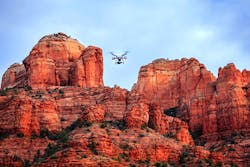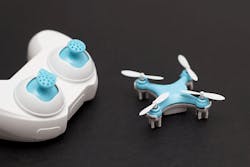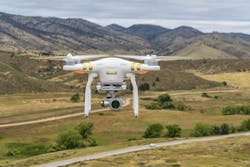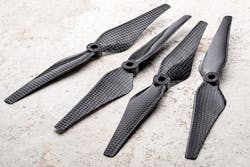This file type includes high-resolution graphics and schematics when applicable.
A confluence of technologies and manufacturing capabilities has led to an onslaught of remotely controlled quadcopters in the hands of hobbyists. Low-cost motors and mass-produced propellers provide the power to keep them in the air. Weight is kept down, but structural integrity is maintained by strong, engineered plastics and composites. And chip-based controllers, gyros, navigation, and cameras give them high-end capabilities and features while keeping costs down.
Currently, it looks like aerial photography is one of the main attractions for those people flocking to purchase RC quadcopters (qcopters). The aircraft are so useful for photography (and inexpensive compared to the alternatives), even professional videographers are jumping on the qcopter bandwagon and referring to them as flying cameras rather than qcopters or drones. In fact, some qcopters come with cameras as built-in equipment that are not designed to be removed.
It’s also possible that interest in racing leagues and even air-to-air combat competitions will add to qcopters’ popularity. In fact, one wing of the quadcopter fan club is dedicated to first-person-viewing (FPV) racing. Users fly mid-priced qcopters with cameras mounted on the front. The drone sends images back to the pilot who views them on a small screen or, preferably, on immersive googles. The view as the agile little flyers zip across the landscape and up and around trees and other obstacles is breathtaking. (There are hours of FPV videos on YouTube.)
Accidents can be catastrophic, but the high-value components—the motors, camera, and microprocessor controls—are fairly well protected and can be cobbled into another qcopter. Do-it-yourself qcopters are common in the FPV world. There are even rumors of one homebuilt drone with souped-up components and all the extra weight removed that can fly 62 mph.
Quadcopters come in a wide variety of sizes, complexities, capabilities, and cost. It’s no surprise that on the low end, size and payload are extremely limited, as is control range, top speed, and how long they can remain airborne on a charged battery. Some are so small that they are almost restricted to indoor flying where there is no wind. Less-expensive quadcopters also lack the control algorithms that make it easy for novices to control them in the air rather than watch as they slam into trees and buildings while flailing with the RC controller. The high-end qcopters, those costing over $3,000, are chockful of features and capabilities that likely wouldn’t have been possible 10 years ago.
Keeping Them in the Air
Qcopters have four identical motor and-vertical-propeller (rotor) assemblies divided in two pairs, with each pair spinning in opposite directions (CW and CCW). There are also six-, eight-, and 12-rotor versions, but they all use the same basic principles. The motor and rotor assemblies that spin in the same direction are mounted opposite each other.
Each rotor creates lift in direct proportion to the speed of the motor and only spins in one direction. They are simple, inexpensive single-piece rotors that do not change their pitch. When all four motors spin at the same speed, a qcopter will climb, descend, or hover (neglecting wind). The torque from the motors is balanced and the aircraft will not spin.
To control a qcopter’s direction of flight, speed, altitude, and attitude (in response to the user’s controls), the motors spin at different speeds to set up the desired turning moment and thrust vector. Qcopters’ design makes them inexpensive yet reliable in doing this split-second torque-balancing act. For example, the rotors are plastic or composites and lightweight. So the motors can almost instantly slow down or speed up their rotation, something much more difficult, if not impossible, on a full-sized helicopter’s rotors. This lets the control chip balance torques quickly and smoothly.
The motor-control subsystem is also relatively inexpensive, thanks to Moore’s law and a large number of chips being manufactured. Chips also control GPS navigation, aiming and controlling the camera, and gyros and accelerometers.
The motor controller, for example, is driven mainly by command inputs from the RC controller the operator uses. It delivers commands for throttle, pitch, yaw, and direction of flight though joysticks and a few buttons. (The controller setup depends on the qcopter’s make and model.) The controller meshes the command inputs with those from its suite of sensors, which differ for various make and model of qcopters. One of the most important sensors for control—and most of these aircraft carry one—is a six-axis gyro.
The term “six-axis gyro” is somewhat of a misnomer. They are actually three-axis gyros, with gyros for the pitch, roll, and yaw axes that are either combined with a three-axes accelerometer or wired and programmed to also function as a three-axis accelerometer. In simple terms, the gyro determines the rotational rate about an axis and the accelerometer determines the rotational position about an axis.
Adding the three accelerometer readings to the motor controller gives it some additional capabilities. For example, if the operator gets the qcopter in an inverted attitude or a spin, letting go of the controls lets the aircraft right itself based on the accelerometer inputs and come to a hovering halt (assuming there’s enough vertical distance to recover). The accelerometers also let the qcopter fly relatively straight and level despite winds or overcome sideslip to make smooth turns. Another favorite among qcopter enthusiasts are aerial flips, which are difficult without a six-axis gyro.
High-End Features and Capabilities
Many qcopters let operators choose from several flying modes. At the lowest level, operators are limited in the amount of pitch and roll they can command. This helps eliminate over-control and subtly teach the pilot how to keep the qcopter flying and headed in the right direction. Higher modes then expand the control envelope, giving the operator more responsibilities and more capabilities. This lets operators climb the learning curve at their own pace without crashing too many qcopters.
Another feature that prevents operators from losing their drones is the “return home” command. Hit the right button, or tap the right sequence and your quadcopter makes a beeline for you, having stored its departure point in its GPS. More sophisticated drones take this feature one step farther. They monitor their battery power and the distance to “home base” and when their computer determines they have just enough power to make it home, they stop the mission and fly to you.
GPS also lets qcopters fly from one way point to another, getting out of range of the operator’s controller sight, and flying on their own. Some drones, those with flying times of almost 30 minutes, can fly up to eight or nine miles from their launch point. (Don’t tell the FAA.; for more, check out "The FAA on Quadcopters").
High-end video models let operators program them to track a transponder small enough to fit in a shirt pocket. Operators can set certain parameters so that, for example, it flies 30 ft. behind and 20 ft. above the transponder. The operator can then ski, surf, ride a bike or motorcycle, and the qcopter tracks the transponder’s radio signal to stay above and behind while it films the action.
Both the qcopters and their cameras can carry out quite complex commands, almost more than one person can cope with. To spread the workload, higher-end drones have two controllers: one for flying and navigating, and the other for controlling the camera. Other qcopters let a second person use a smartphone to handle some functions. This lets the camera operator pan and change focus on the gimbal-mounted camera while the pilot swoops down for a circling shot. Meanwhile, three-axis stabilization isolates the camera from vibrations for smoother shots.
Qcopters can also be equipped with obstacle avoidance. Using ultrasound transceivers sweep the air in front them, detecting objects or obstacles 65 ft. in front of them. If they spot something, they try fly around it, then get back on course or head to the next waypoint.
Some companies are making aftermarket add-ons for qcopters. There are “missile launchers” that shoot up to six small, plastic missiles singularly or all at once; “water cannons” that are more like aerial squirt guns; bubblers that leave a trail of bubbles in the drone’s wake; and grappling hooks that can lift items, as long as they don’t weigh too much.
Looking for parts? Go to SourceESB.
